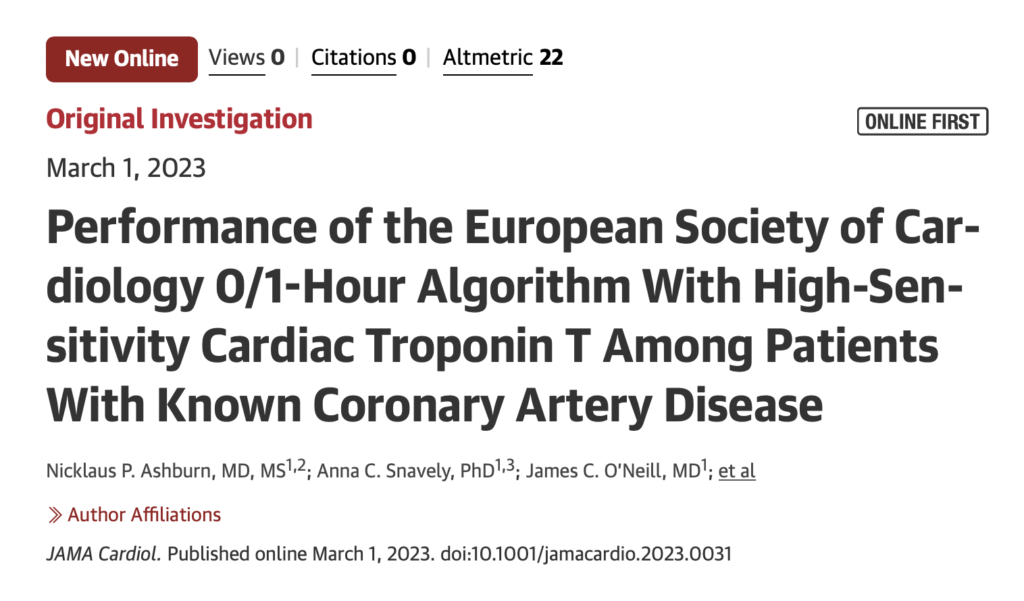A patient presenting with chest pain can be a diagnostic dilemma. Especially if there is no or little change in the ECG. The bedrock of diagnosing acute myocardial infarction rests on rise and fall in troponin level. With advent of high sensitivity troponin European and Australian cardiology societies have adopted a 0/1 hour algorithm. High sensitivity troponin is assessed at entry into the emergency and then later after 1 hour; if both values are within normal limits, subsequent myocardial infarction or death can be ruled out with great certainty.
High-sensitivity troponin assays are the preferred biomarker for the detection of myocardial injury. Levels are reported in ng/L. The assay-specific 99th percentile upper reference limit is the threshold for the diagnosis of myocardial injury.
The 0/1 hour high sensitivity troponin algorithm has now been been studied in patients with a history of coronary artery disease presenting to Emergency. Patients with known coronary artery disease compared to those without coronary artery disease were older , and more likely to be male.
The researchers have reported that in the rule out zone , 30 day death or myocardial infarction occurred in 3.4% of patients with coronary artery disease while it occurred in 1.1% patients without. The negative predictive value (NPV) of 0/1 hour algorithm did not achieve the 99% or more for the primary endpoint. Moreover addition of the History, Electrocardiogram, Age, Risk Factor, and Troponin (HEART) score did not significantly improve the NPV.
In the 1462 patients studied NPV of the 0/1 hour algorithm was 99% for an index myocardial infarction and 98.4% for 30 day cardiac death or myocardial infarction. The NPV’s improved with addition of clinical score to 99.5% and 99.3%. The negative predictive value for 30-day cardiac death or MI was 96.6% (95% CI, 92.8-98.8) among patients with known CAD and 98.9% (95% CI, 97.8-99.6) in patients without known CAD (P = .04).
Among patients with known CAD, the ESC 0/1-hour high sensitivity troponin algorithm was unable to safely exclude 30-day cardiac death or MI. This suggests that clinicians should be cautious if using the algorithm in patients with known CAD. The negative predictive value was significantly higher in patients without a history of CAD but remained less than 99%.
With death or myocardial infarction (MI) within 30 days excluded based on this high-sensitivity cardiac troponin algorithm, people with a known history of coronary artery disease still experienced this outcome in 3.4% of cases.
“This 3.4% missed 30-day death or MI rate is higher than the 1% miss rate most emergency clinicians are generally willing to accept. Thus, our results suggest that the ESC 0/1-hour hs-cTnT algorithm does not safely rule out ACS [acute coronary syndrome] in patients with known CAD,” the authors wrote in their paper published 2 days ago in JAMA.
Hence for the 0/1 hour algorithm to work the NPV must be greater than 99%, and this has been accepted by almost all researchers in this field. The other practical choice of course is to increase the interval for testing of high sensitivity troponin, which may drain hospital recourses.
An integrated approach for risk stratification — including patient history, electrocardiogram, and serial high sensitivity troponin — as recommended in the 2021 American Heart Association/American College of Cardiology chest pain guidelines would be the most pragmatic approach.
To conclude clinical judgement based on experience should always trump over an algorithm created by a cardiology association. Can a 99% value be better than 98.9%, most probably not.
